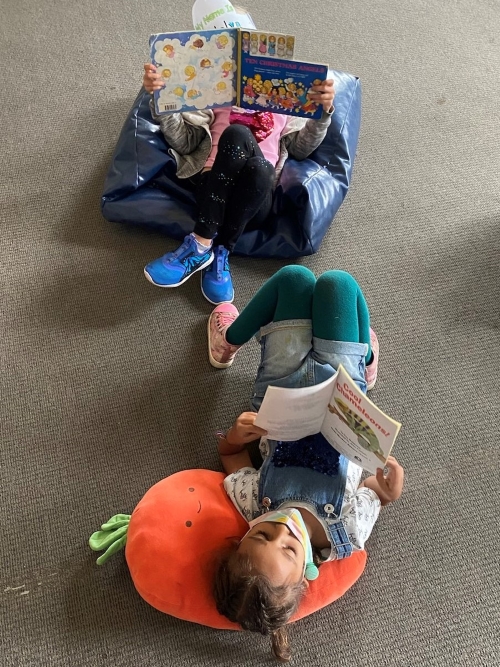Encouraging a Love of Reading

We all know that reading is foundational for education. Not only do children who are avid readers have a large academic advantage over their counterparts, but those who love to read are much more likely to turn into lifelong learners. Reading is a gift from God that connects us to people around the globe and throughout history, opening up worlds of ideas and the power of story in our lives.
Unfortunately, today the percentage of children who are avid readers is lower than ever, and it can be difficult to ignite in students a love of reading when we’re competing with all the screens and media present in today’s culture. But we can’t give up!
First as a homeschooling mom and then as a librarian, I’ve spent a lot of time considering ways we can encourage a love of reading in our students. Some principles that I live by include:
Choice: Give students choice in what they read. This is critical. Kids will be more enthused about a book they choose themselves, and getting to choose helps them to discover what kind of books they enjoy.
What if a book is too easy? Reading books that are easy develops reading speed and fluency. And who doesn’t like to revisit old, familiar favorites? The lesson that reading can be relaxing is a great one too.
What if it’s too hard? The student will discover that. A little trial and error can help them learn how to find books at their level. Or maybe if it’s something they are highly motivated to read, they will rise to the challenge and work through it.
Focus on the joy: Many reading programs focus on external motivation to get kids to read: awards, prizes, and so on. There is a place for that, and prizes are fun. But studies show that if we rely only on extrinsic motivators, we can fail to create the intrinsic motivation that children need to keep reading.
Minimize the drudgery: I understand that teachers need to make sure kids are reading, and sometimes rely on reading reports, log sheets, etc. to make sure it’s happening. At the same time, these things can sap the joy out of reading, even for kids who already love to read. A weekly notation of titles read with a quick conversation about them is better than making students count the minutes and pages every time they pick up a book.
Be a role model: Model reading habits. Sharing with your students what you’re reading can help them catch your enthusiasm. Give students an opportunity to share too. Enthusiasm is contagious.
Last and most important: Read Aloud! Reading aloud is the single greatest tool in igniting a love of reading in children, and its benefits truly can’t be underestimated.
Reading aloud allows children to enjoy a story that is too difficult for them to read themselves. Generally, children can understand a story that’s at least two grade levels above their independent reading ability. When we read to them, we give them a vision for the kind of books they’ll be able to read for themselves someday.
Through read-alouds, a student’s imagination grows. Converting text that you read or hear into action in your mind is a learned skill. Listening to stories helps them gain that skill earlier – leading to more enjoyment of reading.
A story read aloud also bonds them with the reader and everyone else enjoying the story. Afterwards, your class or family can discuss the story together.
In addition to all those benefits, reading aloud accomplishes things that I haven’t found  any other way to do. For instance, it demonstrates the old adage, “You can’t judge a book by its cover.” I don’t know how many times we started a book that my kids were not enthused about, only to find them hooked and loving it mid-way through. This also teaches kids patience. Maybe the book doesn’t start off with action from the first page but reading together gives the students time to get into it. Too often, kids left to their own devices will start a book and drop it when it doesn’t catch them right away. Sometimes that’s ok, of course, but if it’s a regular pattern, the student may never develop the patience for longer, more complex literature.
any other way to do. For instance, it demonstrates the old adage, “You can’t judge a book by its cover.” I don’t know how many times we started a book that my kids were not enthused about, only to find them hooked and loving it mid-way through. This also teaches kids patience. Maybe the book doesn’t start off with action from the first page but reading together gives the students time to get into it. Too often, kids left to their own devices will start a book and drop it when it doesn’t catch them right away. Sometimes that’s ok, of course, but if it’s a regular pattern, the student may never develop the patience for longer, more complex literature.
For all these reasons, I read to students every chance I get, and I’m so happy to hear our classroom teachers are reading to them too. Together we can all help ignite a love of reading in our students.
If you’d like more information, two great books on the topic are The Book Whisperer by Donalyn Miller[1] and The Read-Aloud Handbook by Jim Trelease[2].
Tricia Fraser
Librarian
International Christian School, Budapest
[1] Miller, D. (2009). The book whisperer. Jossey-Bass.
[2] Trelease, J. (2013). The read-aloud handbook. Penguin Random House.
Photo Credits:
Library. Bingham Academy
Students Reading. Bingham Academy
Read-Aloud. E. Burnham
